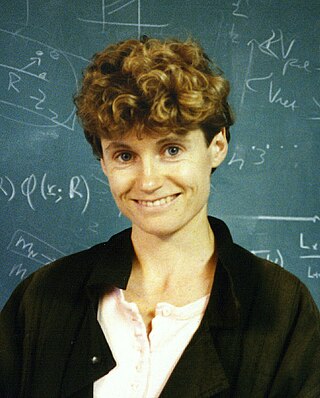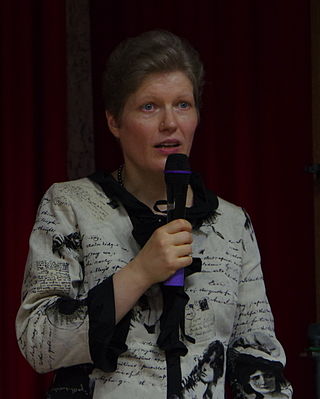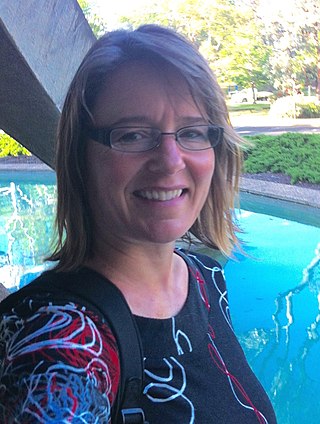
The Niels Bohr Institute is a research institute of the University of Copenhagen. The research of the institute spans astronomy, geophysics, nanotechnology, particle physics, quantum mechanics, and biophysics.

Sandra Moore Faber is an American astrophysicist known for her research on the evolution of galaxies. She is the University Professor of Astronomy and Astrophysics at the University of California, Santa Cruz, and works at the Lick Observatory. She has made discoveries linking the brightness of galaxies to the speed of stars within them and was the co-discoverer of the Faber–Jackson relation. Faber was also instrumental in designing the Keck telescopes in Hawaii.

Astrophysics is a science that employs the methods and principles of physics and chemistry in the study of astronomical objects and phenomena. As one of the founders of the discipline, James Keeler, said, Astrophysics "seeks to ascertain the nature of the heavenly bodies, rather than their positions or motions in space–what they are, rather than where they are." Among the subjects studied are the Sun, other stars, galaxies, extrasolar planets, the interstellar medium and the cosmic microwave background. Emissions from these objects are examined across all parts of the electromagnetic spectrum, and the properties examined include luminosity, density, temperature, and chemical composition. Because astrophysics is a very broad subject, astrophysicists apply concepts and methods from many disciplines of physics, including classical mechanics, electromagnetism, statistical mechanics, thermodynamics, quantum mechanics, relativity, nuclear and particle physics, and atomic and molecular physics.
The cuspy halo problem refers to a discrepancy between the inferred dark matter density profiles of low-mass galaxies and the density profiles predicted by cosmological N-body simulations. Nearly all simulations form dark matter halos which have "cuspy" dark matter distributions, with density increasing steeply at small radii, while the rotation curves of most observed dwarf galaxies suggest that they have flat central dark matter density profiles ("cores").

Rebecca Anne Wood Elson was a Canadian–American astronomer and writer.
Amy J. Barger is an American astronomer and Henrietta Leavitt Professor of Astronomy at the University of Wisconsin–Madison. She is considered a pioneer in combining data from multiple telescopes to monitor multiple wavelengths and in discovering distant galaxies and supermassive black holes, which are outside of the visible spectrum. Barger is an active member of the International Astronomical Union.

Carlos Silvestre Frenk is a Mexican-British cosmologist. Frenk graduated from the National Autonomous University of Mexico and the University of Cambridge, and spent his early research career in the United States, before settling permanently in the United Kingdom. He joined the Durham University Department of Physics in 1986 and since 2001 has served as the Ogden Professor of Fundamental Physics at Durham University.

Eva K. Grebel is a German astronomer. Since 2007 she has been co-director of the Astronomisches Rechen-Institut at the University of Heidelberg in Germany. Eva Grebel is an expert in the study of stellar populations and galaxy formation.

Priyamvada (Priya) Natarajan is a professor in the departments of astronomy and physics at Yale University. She is noted for her work in mapping dark matter and dark energy, particularly with her work in gravitational lensing, and in models describing the assembly and accretion histories of supermassive black holes. She authored the book Mapping the Heavens: The Radical Scientific Ideas That Reveal the Cosmos.
Rachel S. Somerville is an American astronomer and holds the George A. and Margaret M. Downsbrough Chair in Astrophysics at Rutgers University. She is known for theoretical research into galaxy formation and evolution. She was awarded the 2013 Dannie Heineman Prize for Astrophysics “For providing fundamental insights into galaxy formation and evolution using semi-analytic modeling, simulations and observations.”
Ma Chung-pei is an astrophysicist and cosmologist. She is the Judy Chandler Webb Professor of Astronomy and Physics at the University of California, Berkeley. She led the teams that discovered several of largest known black holes from 2011 to 2016.
Emily Levesque is an American astronomer and assistant professor in the Department of Astronomy at the University of Washington. She is renowned for her work on massive stars and using these stars to investigate galaxy formation. In 2014, she received the Annie Jump Cannon Award for her innovative work on gamma ray bursts and the Sloan Fellowship in 2017. In 2015, Levesque, Rachel Bezanson, and Grant R. Tremblay published an influential paper, which critiqued the use of the Physics GRE as an admissions cutoff criterion for astronomy postgraduate programs by showing there was no statistical correlation between applicant's score and later success in their academic careers. Subsequently, the American Astronomical Society adopted the stance that the Physics GRE should not be mandatory for graduate school applications, and many graduate astronomy programs have since removed the Physics GRE as a required part of their graduate school applications. She is also the author of the 2020 popular science book The Last Stargazers: The Enduring Story of Astronomy's Vanishing Explorers.

Vassiliki Kalogera is a Greek astrophysicist. She is a professor at Northwestern University and the director of the Center for Interdisciplinary Exploration and Research in Astrophysics (CIERA). She is a leading member of the LIGO Collaboration that observed gravitational waves in 2015.

Burçin Mutlu-Pakdil is a Turkish-American astrophysicist, and Assistant Professor at Dartmouth College. She formerly served as a National Science Foundation (NSF) and Kavli Institute for Cosmological Physics (KICP) Postdoctoral Fellow at the University of Chicago. Her research led to a discovery of an extremely rare galaxy with a unique double-ringed elliptical structure, which is now commonly referred to as Burcin's Galaxy. She was also a 2018 TED Fellow, and a 2020 TED Senior Fellow.

Kim A. Venn is a professor of physics and astronomy at the University of Victoria, Canada, and director of the university's Astronomy Research Centre. She researches the chemo-dynamical analysis of stars in the galaxy and its nearby dwarf satellites.
Jessica K. Werk is an American astronomer and an associate professor in the Department of Astronomy at the University of Washington. Her work includes the study of intergalactic and interstellar media. Werk was a Hubble fellow at the University of California, Santa Cruz from 2013 to 2016, and won the $65,000 Sloan Fellowship in 2018. Her research focuses on the role of gas in the formation and evolution of galaxies and the intergalactic medium, primarily through spectroscopic observations in the optical and ultraviolet.
Blakesley Burkhart is an astrophysicist. She is the winner of the 2017 Robert J. Trumpler Award awarded by the Astronomical Society of the Pacific, which recognizes a Ph.D. thesis that is "particularly significant to astronomy." She also is the winner of the 2019 Annie Jump Cannon Award in Astronomy and the 2022 winner of The American Physical Society's Maria Goeppert-Mayer Award. The awards both cited her work on magnetohydrodynamic turbulence, and for developing innovative techniques for comparing observable astronomical phenomena with theoretical models.
Anna Elisabeth Krause is a German-American astronomer and assistant professor of physics at the University of Arizona.

Brad Gibson is an Australian-Canadian astrophysicist. He is the Head of the Department of Physics & Mathematics, and Director of the E.A. Milne Centre for Astrophysics, at the University of Hull. He is known for identifying the regions of the Galaxy most likely to harbor complex biological life, designing and constructing the first operational liquid mirror telescope observatory, and using supernovae as cosmological probes, the latter for which led to the 2009 Gruber Prize in Cosmology. A passionate advocate for Widening Participation, Gibson delivers more than 100 presentations annually to schools and the general public; his Changing Face of Physics campaign has been highlighted as Good Practice by the UK Equality Challenge Unit.

Marc S. Seigar is an astrophysicist, academic and author. He is the Dean of the College of Natural Sciences and Mathematics, and a Professor of Physics and Astronomy at the University of Toledo.











